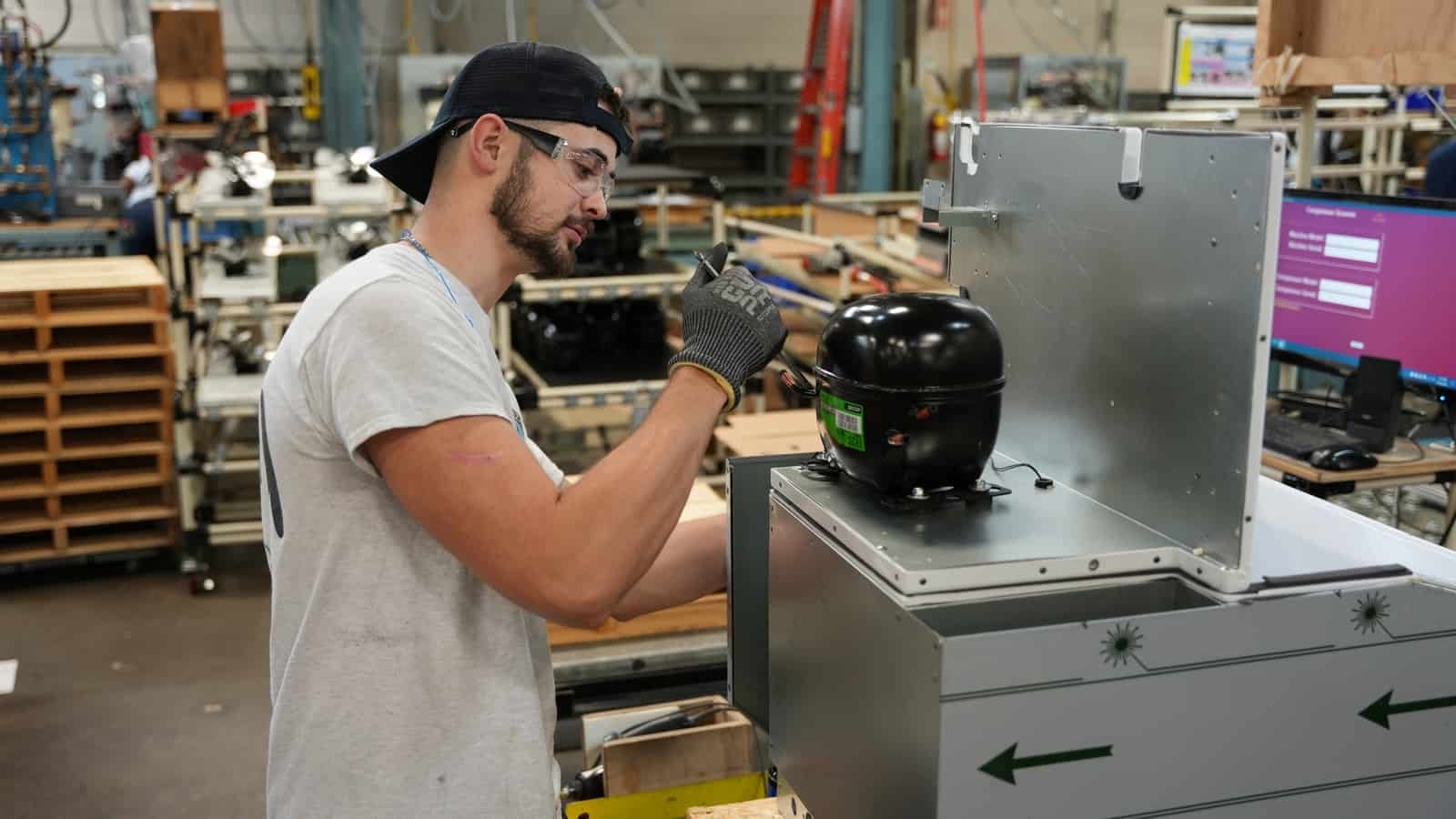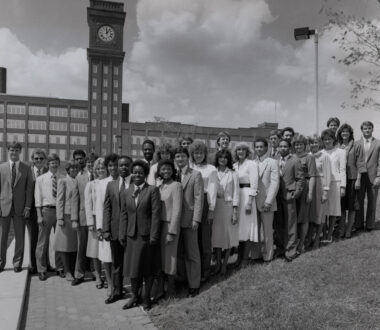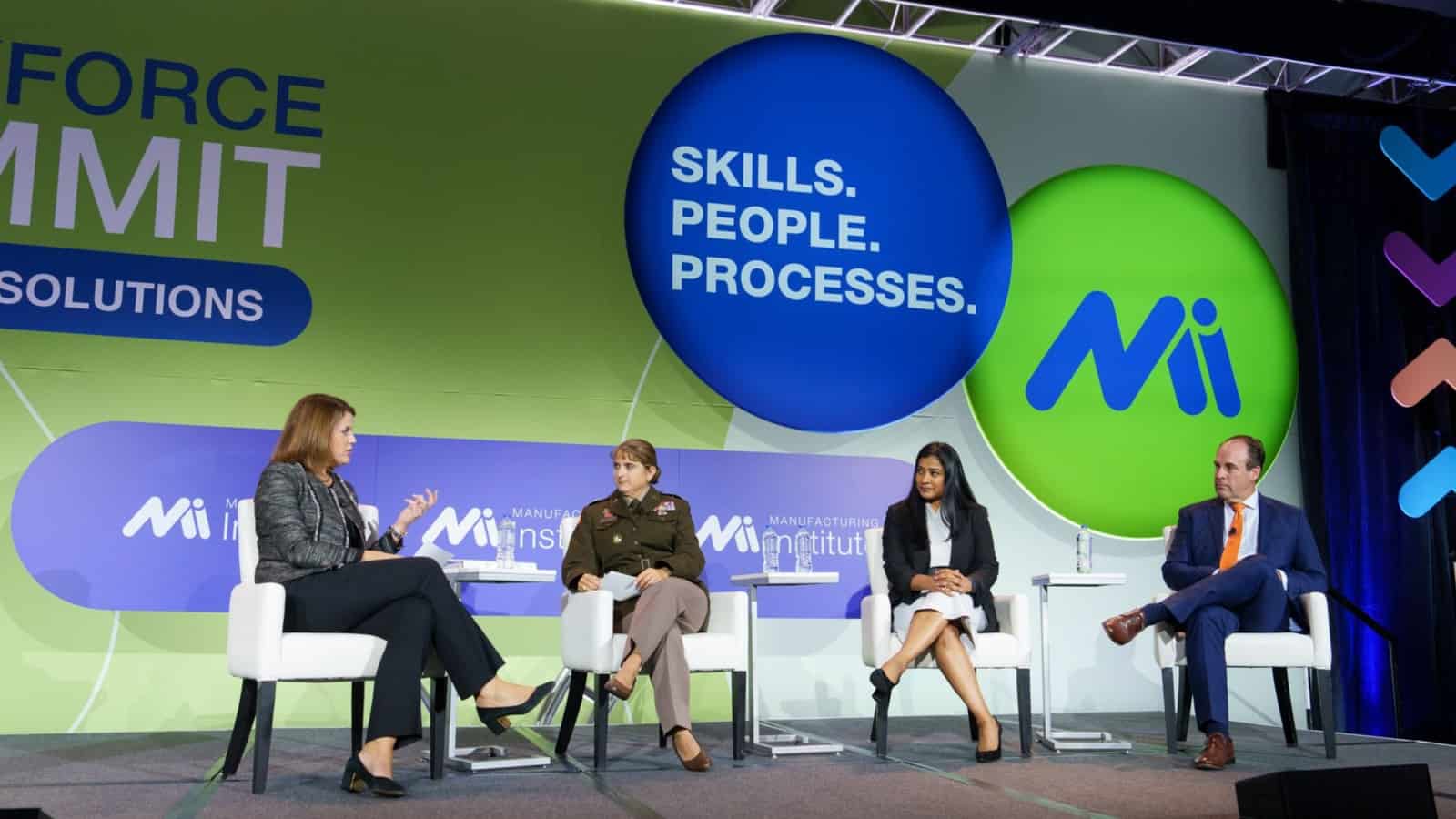Study: Price Controls Could Harm Pharmaceutical Manufacturing

The pharmaceutical manufacturing industry is a critical piece of the U.S. economy, creating well-paying, valuable STEM jobs and contributing large sums in value-added output. However, federal price controls could threaten these benefits, according to a new study from the NAM.
What’s going on: The analysis, “Creating Cures, Saving Lives,” was released Wednesday and analyzes the industry’s contributions to the overall economy, as well as ways in which it could be affected by federal price control policies, such as those in last year’s Inflation Reduction Act.
- In August, the Department of Health and Human Services announced that it had chosen the first 10 drugs for prescription-cost negotiations required by the legislation.
- Last month, all 10 manufacturers “agreed to participate essentially because they had no choice,” according to reporting by The Hill.
Why it’s important: Controls on drug prices jeopardize innovation and competitiveness—which is why the NAM has long opposed them.
- What’s more, pharmaceutical manufacturing is a major contributor to the American economy, and government regulations should help, not hinder, it.
- “Pharmaceutical manufacturers are a major contributor to the U.S. economy, employ[ing] millions of Americans and driv[ing] innovation,” said NAM Chief Economist Chad Moutray. “The industry’s investments in R&D have led to lifesaving treatments and therapies that have improved the quality of life for all Americans. This study explores the negative implications of price control policies on pharmaceutical leadership, putting American jobs and innovation in the health care system at risk.”
NAM Fights Auto Regulation Mess

Manufacturers spend years developing and delivering top-of-the-line vehicles for consumers. But as policymakers set new fuel standards and regulations for light vehicles, automakers are finding themselves caught in a tangled mess of policy-making that threatens manufacturers and consumers alike.
Too many regulators: A number of agencies and government bodies, along with the state of California, are each imposing their own fuel-efficiency standards and environmental regulations, forcing automakers to cope with the conflicts and contradictions.
- “Right now, we’re looking at multiple sets of standards,” said NAM Vice President of Domestic Policy Brandon Farris. “That includes the Department of Energy, the Environmental Protection Agency and the National Highway Traffic Safety Administration, as well as separate standards from California. Each has standards for vehicle emissions, and they’re not well-aligned.”
Brief timelines: In addition, all of these regulations come with their own timelines for compliance, which often don’t give manufacturers enough time to innovate, test and produce new vehicles.
- “The timelines are short,” said Farris. “One of the things we’re asking agencies to recognize is the manufacturing lead time that’s needed.”
Product mandates: In some cases, agencies are imposing mandates that will narrow the range of vehicles that automakers can produce. The EPA, for example, is calling for 67% of all new vehicles to be battery electric in 10 years, a requirement that would squeeze out other fuel-efficient models.
- “What that’s going to do is cut down on consumer choice,” said Farris. “There are conventional hybrids, plug-in hybrids, hydrogen fuel cell vehicles, battery electric vehicles and others that could all reduce emissions, but the EPA has cut out all of those and selected one kind of technology.”
Read the full story here.
SEC Reverses Course After NAM Legal Challenge

The NAM secured a critical win Monday when the Securities and Exchange Commission issued an order reversing course on a novel rule interpretation that would have forced private companies to disclose proprietary financial information publicly, Law 360 (subscription) reports.
What’s going on: In 2021, the SEC adopted a novel reinterpretation of SEC Rule 15c2-11, imposing the rule’s public disclosure requirements on private companies that raise capital via corporate bond issuances under SEC Rule 144A—without giving manufacturers the opportunity to provide comment on the damaging impacts of such a consequential change.
- The NAM and the Kentucky Association of Manufacturers pursued multipronged litigation and advocacy efforts arguing to the Commission and to the courts that the SEC’s actions were both procedurally improper and substantively indefensible.
- Rule 15c2-11 requires public disclosures for the protection of everyday investors in publicly traded companies that issue so-called “penny stocks.”
- But in 2020, the SEC expanded the rule to apply to privately held companies issuing corporate bonds to large institutional investors under Rule 144A.
- For decades prior, Rule 144A permitted trades in private companies’ fixed-incomes securities without public disclosure of the issuers’ financial information. Indeed, the SEC’s entire purpose for adopting Rule 144A was to allow companies to access the debt markets without public disclosure of their financial and business-strategy information.
NAM in the news: The SEC took the rare step of reversing its position on Monday, declaring that “it is appropriate in the public interest and consistent with the protection of investors” to exempt Rule 144A fixed-income securities from the requirements of Rule 15c2-11.
- “The order comes after industry groups petitioned the agency to provide relief to certain corporate debt issuers. The National Association of Manufacturers and the Kentucky Association of Manufacturers, which sought such relief in November 2022, also sued the agency in September, arguing that the SEC’s policy was enacted without public input and could harm job-creation efforts, given how many private companies rely on 144A bonds,” Law360 reports.
- Bloomberg Tax (subscription) also covered the news.
Why it’s important: Expansion of Rule 15c2-11 would have meant higher borrowing costs and less liquidity in the market—and resulted in more than 100,000 job losses a year, according to recent EY analysis prepared on behalf of the NAM.
Our take: The SEC’s action not only restores private companies’ ability to access the debt markets, but also exemplifies why the NAM litigates—as a last line of defense, to force an agency’s hand.
- “This order from the SEC is a landmark victory for manufacturers and a powerful affirmation of the NAM Legal Center’s ability to rein in regulatory overreach,” NAM Chief Legal Officer Linda Kelly said Tuesday. “We are thrilled that the Commission has reversed course on this unlawful attempt to impose a novel, onerous and wholly unjustified regulatory mandate on private companies.”
- Added KAM President and CEO Frank Jemley: “We applaud the SEC’s decision to withdraw its ill-conceived proposal. American business and free enterprise are best served when government respects the boundaries of its authority, which the SEC clearly did not do in this matter.”
Refrigerator Manufacturers Call for a Regulatory Freeze

If you’ve ever found yourself grateful for a cold beverage on a hot day, chances are you’ve got Hoshizaki America to thank. The company was established in Los Angeles, California, in 1981 and is one of the leaders in commercial refrigeration, manufacturing refrigerators and icemakers that are used in hotels, hospitals, arenas, schools and more.
Its manufacturing facility was completed in Peachtree, Georgia, in 1986, and it proudly makes its products in America—but in recent years, that commitment has become much more costly.
The problem: Manufacturers like Hoshizaki America are meticulous in adhering to the energy and environmental standards put forth by federal agencies, including the Environmental Protection Agency and the Department of Energy. However, the increased pace of regulation and a lack of coordination between agencies are making it impossible to keep up, according to Hoshizaki America Compliance Engineer Stephen Schaefer.
- “We have many agencies that we have to talk to and be in compliance with, and right now, we’ve got a lot of things coming to a head all at the same time,” said Schaefer.
- “The Department of Energy is setting minimum energy-efficiency standards, the EPA is saying what refrigerants we’re allowed to use, and we’ve got safety standards being updated. That’s a lot of testing and evaluation.”
The timeline: It isn’t just the volume of work that needs to be done; it’s also the short timelines. Appraisals of the industry’s products used to come every six or seven years, allowing companies to develop new technologies to meet new regulations.
- But now, as different agencies offer different rules on overlapping and shorter timelines, companies are finding it impossible to research, build and test new products in time.
- “We fully agree that there are things we want to do environmentally, but there needs to be time given,” said Schaefer.
The scope: Hoshizaki isn’t alone. Schaefer is chair of the Technical Liaison Committee for the North American Association of Food Equipment Manufacturers, and much of the organization’s membership is experiencing the same challenge.
- According to a recent NAFEM survey of its membership, 66% of the companies indicated that their biggest challenges are the volume of regulations and cost of compliance.
The tradeoff: Schaefer argues that meeting these overlapping and pressing deadlines requires diverting funds that would otherwise be used for innovation. If companies are forced to spend more money figuring out how to meet requirements using existing products, they will have less money to spend on developing new products.
- “When different standards like this go into place, you’re taking away from ingenuity for new products and just making sure that existing products can be sold,” said Schaefer. “It becomes very tough to have newer innovation.”
- In the NAFEM survey, respondents said that if the regulatory burden was eased, they would be able to redirect funds to purchase new equipment, hire more employees, increase wages and benefits and reinvest in their manufacturing business.
The bottom line: “We want to help environmentally in every way possible—to be a good steward for energy efficiency and environmental concerns,” said Schaefer. “But we also want agencies to work together for the same goals, in a fair way that doesn’t impede ingenuity or increase the cost to the end user.”
Read more: Federal regulations are burdening manufacturers disproportionately—costing small companies an average of $50,100 per employee, according to a new NAM-commissioned study.
How Goodyear and Akron Thrive Together

This year, one of the most recognizable brands in America turned 125. Goodyear, the manufacturer of tires for everything from cars to planes to lunar rovers, celebrated its anniversary in style, including by flying the famous blimps over its hometown of Akron, Ohio.
The company’s deep ties to Akron have been apparent throughout its more than a century in business. We spoke to Senior Vice President and Chief Communications Officer Laura Duda recently about that history and what other manufacturers can learn from it.
The beginning: Goodyear was founded in 1898, when F.A. “Frank” Seiberling purchased two empty factories in Akron’s then-small downtown, Duda told us.
- The company brought thousands of jobs to the neighborhood known as Middlebury and is still operating there more than a century later, having built its new headquarters on Innovation Way in 2014, just blocks away from its previous headquarters.
- The company also built its largest innovation center in Akron around the same time, as well as one of its three airship bases. Its Akron facilities also include a plant that produces racing tires, a test track that helps the company develop and bring innovative products to market and much more—all in the place it first called home.
Growing together: In addition to creating and keeping jobs in Akron, Goodyear prides itself on its contributions to the expansion of the city throughout the company’s history, Duda said.
- Seiberling himself developed a neighborhood called Goodyear Heights, which offered affordable housing to the company’s workers and remains a beloved historic district today.
- Meanwhile, the city’s first municipal bus system was constructed to bring the company’s workers downtown to the factory, and Goodyear’s early leaders created the surrounding county’s public parks.
- “It’s not possible to separate the history of Akron from the history of Goodyear,” Duda concluded.
Recruiting locally: Ever since its founding, Goodyear has always prioritized local recruitment, said Duda, and worked to set employees up for long, productive tenures at the company.
- In 1913, Goodyear’s first CEO, Paul Litchfield, set up an early in-house training program called the “flying squadron,” which helped associates learn new skills and advance in their careers. Today, the descendant of that
 program is known as “Sales Squad,” Duda said, and serves to “attract talent to and kickstart the company.”
program is known as “Sales Squad,” Duda said, and serves to “attract talent to and kickstart the company.” - This program recruits recent college graduates for full-time positions across the country, using a 10-week training program designed to prepare candidates for a career at Goodyear by providing experiences within the company’s retail, sales, manufacturing and product development departments.
- Goodyear also offers developmental programs throughout the company, via a learning center that provides both in-person and take-home training resources.
- Lastly, the company collaborates with STEM programs in schools both in the Akron area and around the country, sending its engineers out to tell students about Goodyear’s many rewarding career paths.
Still giving back: Today, Akron is a well-established city with significant infrastructure, and Goodyear is still contributing to the city’s future.
- “It’s unusual to find an area of community support where Goodyear is not engaged,” said Duda. “We focus on building ‘safe, smart and sustainable communities.” The company’s “safe” pillar includes a partnership with Akron’s Children’s Hospital to provide car seats to parents who can’t afford them and bike helmets to older children. “Smart” projects include efforts to promote STEM careers among underrepresented students at Akron Public Schools.
- Meanwhile, Goodyear’s focus on sustainability has led it to support the development of the region’s Ohio & Erie Canalway Towpath Trail, along with green space throughout the region.

Blimps: We couldn’t have an interview with Goodyear without asking about the blimps, of course.
- Yes, Duda has ridden in them, she told us, and the experience is “as great as you would expect.”
- Akron also takes great pride in the blimps, which can be a major draw at charity auctions, to which the company often donates rides. A ride for two on a blimp “goes for more money than you might anticipate,” said Duda.
The last word: While it is hard to replicate the sort of community ties and goodwill built up over more than a century, Duda has some advice for manufacturing companies looking ahead to the next 125 years. Not only will they find local leaders very receptive to outreach, she advised, but an enormous amount gets accomplished at local associations and chambers of commerce.
- Just as importantly, manufacturers should know that “your employees want this [level of community engagement],” Duda said. “We hear from top talent that we are recruiting that it is important to them, as well as from our current employees. From a talent perspective, this is something everyone should consider.”
For more on Goodyear’s history, innovations and future plans, check out the company’s engrossing documentary made for the anniversary: 125 Years in Motion.
Environmental Firm Langan Takes on ‘Forever Chemicals’

The race to remove PFAS from its remaining industry uses is on—and according to Langan’s Stewart Abrams, must be “a sprint, not a jog.”
In high demand: Abrams is a principal and director of remediation technology at Langan, a national environmental and engineering firm. He leads the consulting firm’s remediation practice, specializing in the treatment of perfluoroalkyl and polyfluoroalkyl substances, chemical compounds that were used widely in household products—including fire extinguishers—for decades.
- It’s an area of expertise that will soon be highly sought after, given the Environmental Protection Agency’s proposal earlier this year of drinking water maximum contaminant levels (MCL) of 4 parts per trillion (ppt) for both PFOA and PFOS. This will not only affect drinking water but will become an important standard for remediation sites as well.
- Langan has clients—including property owners and developers—who focus on the removal of PFAS from contaminated groundwater.
“What’s possible”: “Part of what Langan is doing is focusing on what is possible” regarding PFAS removal, Abrams said.
- “We’re looking at the treatment of groundwater and drinking water. We’re also working on how to deliver existing and new technologies to site cleanup. We’re going to have to move faster than ever before to bring these technologies to the marketplace. It’s a sprint, not a jog.”
Land remediation: Langan has long worked with property developers, helping them clear land of contaminants before building begins. PFAS issues, however, have changed the game considerably.
- “Now we’re looking at projects [for clients] where the question is, ‘How do you use water or land that’s been PFAS-contaminated?’” Abrams said.
- “Some companies have legacy contamination at the sites” they want to build on, and solutions aren’t always forthcoming, he continued.
Airports and PFAS: Another significant Langan customer sector? The aviation industry. Since 2022, airlines operating at California airports may no longer use PFAS in firefighting foam, a common use of the compounds for many years owing to their fire-extinguishing capabilities.
- “They’ve had to adopt new methods of firefighting at [California] airports,” said Abrams of Langan’s aviation clients in that state. “It’s hard because you need a lot of this fluid to address a fire given the amount of fuel on an airplane. The problem is that often the large water reservoirs at these airports have until recently contained a lot of PFAS.”
- That contamination isn’t limited to the water, Abrams added, but extends to everything the PFAS has touched. “Everything in the [firefighting] systems—the pumps, the nozzles, the piping—are contaminated, as is the storage reservoir itself. Part of the complexity of removal is cleaning all of it and then finding an alternative” surfactant, a chemical compound that can effectively extinguish fire.
- In addition, the sponge-like concrete that often lines the reservoirs at airports may have absorbed the chemical, requiring removal and replacement.
Finding solutions: About a decade ago, Langan and the New Jersey Institute of Technology began an informal research partnership.
- Members of Langan’s staff have access to NJIT’s environmental engineering laboratories, where they can set up experiments to solve client challenges. Now the company is leveraging that relationship to find solutions to PFAS problems.
- The labs are “a great [place] to bring in new ways of doing things with PFAS,” Abrams told us. “We’re exploring new treatment methods, new characterization methods, and we will be working to accelerate those technologies to market.”
Taking practical action: The strong carbon-fluorine bonds in PFAS chemicals render them harder to destroy than other contaminants, Abrams noted.
- “Unlike with other compounds—particularly volatile organic compounds and chlorinated solvents—with PFAS, we can’t quite track down all of it,” he continued. “It’s out there in the environment; it would be extremely difficult to chase down every molecule. Instead, we want to bring a theme of pragmatism to PFAS cleanup.”
Inside the MI’s Pathbreaking Workforce Summit

The best minds tackling manufacturers’ workforce challenges gathered in Atlanta last week to discuss hiring, retention, training and more. The Manufacturing Institute’s workforce summit convened almost 300 manufacturers, partners from education and training groups, philanthropy leaders and representatives from community-based organizations to share insights and brainstorm solutions.
The economic backdrop: Amid a persistently tight labor market, manufacturers are looking for immediate and long-term solutions to attraction and retention challenges.
- Chad Moutray, director of the MI’s Center for Manufacturing Research, provided the larger economic context for attendees, saying that “it’s not hard to be bullish about manufacturing. There continues to be signs of resilience in the sector despite a multitude of challenges.”
- “However, it exacerbates workforce issues, which remain the top concern of manufacturers, especially in a solid labor market,” he added.
Energizing connections: The MI was focused on helping participants learn from each other and form lasting and productive bonds.
- Organizations including the Georgia Association of Manufacturers, Siemens Foundation and River Parishes Community College sent leaders to facilitate conversations and share insights, while the generous support of WestRock, the Arconic Foundation and many others made the event possible.
- In breakout sessions, MI experts analyzed the key challenges facing manufacturers and shared proven workforce solutions like high school internships, female mentorship programs and regional sector partnerships.
Fresh insights: The two-day event was brimming with new ideas and fresh perspectives—too many to list in one article. Here is a brief sampling of the topics covered:
- People: The speakers highlighted manufacturers’ work to create positive company culture, prioritize flexibility and address issues like the shortage of child care. Maj. Gen. Kris Belanger also shared the importance of tapping into military talent pools like the U.S. Army Reserve. Programs like the MI’s Heroes MAKE America are making these important connections.
- Skills: To meet their needs for skilled workers, manufacturers are working with the MI, economic development boards and educational institutions to train the current and next generations of manufacturing employees. Workshop sessions showcased solutions from the MI’s FAME USA program, second chance hiring initiative and student engagement.
- Processes: Conversations in the popular “Brewing Solutions” rooms focused on ways manufacturers and workforce partners could tap into hidden populations, create attractive working environments and address policy barriers that restrict the adoption of innovative solutions.
Fearing you missed out? Don’t worry! There are plenty of ways you can plug into the cutting-edge work of the MI, the NAM’s workforce development and education affiliate.
- Get updates directly from the MI on the latest workforce insights and receive information about registering for the 2024 Workforce Summit.
- Join us as a sponsor for the 2024 Women MAKE Awards in Washington, D.C., on April 18 to support female manufacturing leaders and network with manufacturers and other workforce partners.
- Want more labor data and insights? Sign up for the MI’s comprehensive Workforce in Focus newsletter to stay up to date on the latest workforce trends.
The last word: “The MI’s unique positioning as both an insightful expert of emerging trends within the industry and an effective implementer of proven workforce solutions drives innovative problem-solving,” said MI President and Executive Director Carolyn Lee. “As we face structural workforce shortages, convenings like the MI’s Workforce Summit will continue to be crucial to build the types of partnerships and share important insights needed to ensure the readiness of the manufacturing workforce.”
Creators Wanted Tour Sets New Records at Ohio Finale

The size of the Great Pumpkin at the 116th annual Circleville Pumpkin Show—Ohio’s iconic fall fest—wasn’t the only record shattered there last week. The Creators Wanted Tour, a historic initiative of the NAM and the Manufacturing Institute to build excitement about modern manufacturing careers, reached new highs for engagement at its 20th and final stop.
Driving the news: The show attracted a crowd of more than 400,000, with “Creators Wanted” the most prominent brand seen and heard throughout the entire event. Of show attendees, the Creators Wanted activation pulled in a tour record of 2,024 participants comprising students and chaperones, taking the immersive experience’s overall total to just shy of 17,000 in two years.
- The digital campaign surrounding the stop collected an additional 110,000 email signups from students and career mentors interested in learning more about modern manufacturing careers, bumping the campaign’s email list above 1.6 million.
- The tour stop also saturated local news, with NBC4, 10TV CBS and WTTE Fox all sending live crews to the experience.
Why it matters: The stop, sponsored by the joint venture of Honda and LG Energy Solution and in partnership with the Ohio Manufacturers’ Association, comes at a critical time for the nation’s manufacturers, as they compete against other industries to fill available job openings today and win the interest of young people for the careers of tomorrow.
- For example, Honda and LG Energy Solution need to hire 2,200 workers within two years for their new electrical vehicle battery plant in Fayette County, Ohio.
- At the stop, Honda and LG Energy Solution joint venture associates were on hand to provide information about modern manufacturing careers generally and about opportunities at the EV plant specifically. The traffic around the experience was so robust that all recruiting materials were exhausted before the event wrapped up.
Zoom in: On Saturday night, the Creators Wanted team also reinforced the industry’s commitment to communities by leading the largest parade of the show, in front of tens of thousands who heard the public address system broadcast the industry’s call for creators and highlight the campaign’s career resources at CreatorsWanted.org.
- NAM President and CEO Jay Timmons, a proud son of Circleville and Chillicothe, Ohio, also addressed an assembling of Ohio’s young women leaders and their families, emphasizing their capacity to make a difference in manufacturing careers while at the same time noting mentorship resources available to them through the MI’s Women MAKE America initiative.
- The tour’s innovative approach received strong approval from state and local officials, strengthening the campaign’s ability to reach students and constituents. Ohio Treasurer Robert Sprague, State Auditor Keith Faber, State Sen. Michele Reynolds and State Reps. Brian Stewart and Mark Johnson, among others, stopped by to see what the buzz was all about.

Tour highlights: Beyond the pumpkin-centric celebrations, the tour also took its message of opportunity and rewarding careers to the new, state-of-the-art Logan Elm School, a combined elementary, middle and high school, as well as to students of the Ohio State University’s Center for Design and Manufacturing Excellence.
- At Logan Elm, Timmons was joined by OMA President Ryan Augsburger, Honda and LG Energy Solution joint venture representative and engineer Sandip Suvedi and representatives from Sofidel America. Honda engineer Meredith Reffey, who is now Honda America’s department lead for workforce partnership, joined Timmons and MI President and Executive Director Carolyn Lee at OSU. (The MI is the workforce development and education affiliate of the NAM.)
The big number: Post-tour surveys show that 84% of participants now view the manufacturing sector more positively.
On the record: “Closing our expansive 20-stop, 25,000+ mile tour at such a dynamic event serves as a potent reminder: the heartbeat of manufacturing lies within our communities,” said Timmons. “It’s in the eyes of the young dreamers in the crowd, the hands of our diligent staff and the spirits of every individual who championed our journey.”
- “The Creators Wanted Tour helped us shift perceptions, but we also know the hard work of continuing to improve perceptions and build the workforce of the future goes on,” said Lee. “The Manufacturing Institute, with our scaled-up efforts to drive solutions with manufacturers and across the industry and the robust digital network and resources the campaign has created will build on the tour’s momentum to do even more.”
The last word: “Our aspiration with Creators Wanted was straightforward yet audacious: to transcend traditional boundaries, step out of the corridors of Washington, D.C., and engage directly with communities across the country,” said NAM Managing Vice President of Brand Strategy Chrys Kefalas. “That’s exactly what we and the manufacturers who joined this tour and campaign did, and we’ve made a lasting positive difference in people’s lives that will outlive this tour and help the industry for decades to come.”
Creators Wanted Tour Sets New Records at Ohio Finale

The size of the Great Pumpkin at the 116th annual Circleville Pumpkin Show—Ohio’s iconic fall fest—wasn’t the only record shattered there last week. The Creators Wanted Tour, a historic initiative of the NAM and the Manufacturing Institute to build excitement about modern manufacturing careers, reached new highs for engagement at its 20th and final stop.
Driving the news: The show attracted a crowd of more than 400,000, with “Creators Wanted” the most prominent brand seen and heard throughout the entire event. Of show attendees, the Creators Wanted activation pulled in a tour record of 2,024 participants comprising students and chaperones, taking the immersive experience’s overall total to just shy of 17,000 in two years.
- The digital campaign surrounding the stop collected an additional 110,000 email signups from students and career mentors interested in learning more about modern manufacturing careers, bumping the campaign’s email list above 1.6 million.
- The tour stop also saturated local news, with NBC4, 10TV CBS and WTTE Fox all sending live crews to the experience.
Why it matters: The stop, sponsored by the joint venture of Honda and LG Energy Solution and in partnership with the Ohio Manufacturers’ Association, comes at a critical time for Ohio and the nation’s manufacturers, as they compete against other industries to fill available job openings today and win the interest of young people for the careers of tomorrow.
- For example, Honda and LG Energy Solution need to hire 2,200 workers within two years for their new electrical vehicle battery plant in Fayette County, Ohio.
- At the stop, Honda and LG Energy Solution joint venture associates were on hand to provide information about modern manufacturing careers generally and about opportunities at the EV plant specifically. The traffic around the experience was so robust that all recruiting materials were exhausted before the event wrapped up.
Zoom in: On Saturday night, the Creators Wanted team also reinforced the industry’s commitment to communities by leading the largest parade of the show, in front of tens of thousands who heard the public address system broadcast the industry’s call for creators and highlight the campaign’s career resources at CreatorsWanted.org.
- NAM President and CEO Jay Timmons, a proud son of Circleville and Chillicothe, Ohio, also addressed an assembling of Ohio’s young women leaders and their families, emphasizing their capacity to make a difference in manufacturing careers while at the same time noting mentorship resources available to them through the MI’s Women MAKE America initiative.
- The tour’s innovative approach received strong approval from state and local officials, strengthening the campaign’s ability to reach students and constituents. Ohio Treasurer Robert Sprague, State Auditor Keith Faber, State Sen. Michele Reynolds and State Reps. Brian Stewart and Mark Johnson, among others, stopped by to see what the buzz was all about.
Read the full story here.
How Manufacturers Can Unlock the Power of Data

Manufacturers are using data to improve everything from their supply chains to their workplace culture—and more. Data can lead the way to new innovations, new business models and even new revenue streams. Yet, many manufacturing executives say they are not scaling data-driven use cases successfully, meaning that much of the information they do collect is going to waste.
So how can companies get the most out of their data and ensure they aren’t losing out on key insights?
A unique event hosted by the Manufacturing Leadership Council, the NAM’s digital transformation division, aims to answer these questions and more. “Manufacturing in 2030: The Coming Data Value Revolution,” which will be held on Dec. 6–7 in Nashville, Tennessee, will explore the ways manufacturers can unlock value from their data to boost productivity, value and competitiveness.
On the agenda: This event will have three key areas of focus:
- Data value: Attendees will learn what the future holds for data monetization, data ecosystems and data-driven innovation.
- People and process: They will also hear about the future workforce, including emerging and evolving job roles, data-driven leadership and data culture.
- Technology and data: And lastly, they will peek into a future where artificial intelligence, data visualizations and the industrial metaverse are part of our everyday manufacturing world.
M2030 agenda highlights: The presenters will also share practical insights that participants can put into action right away.
- In “Capturing Intelligence for Business Model Innovation,” IDC’s Bob Parker will examine digital maturity and the future of enterprise intelligence. Parker will explain how to create new business models through enhanced customer experience, as well as how to capture and leverage economies of intelligence.
- In “The Rise of Data Ecosystems,” John Dyck of the Clean Energy Smart Manufacturing Innovation Institute will deliver a practical explanation of Manufacturing-X, Gaia-X and Catena-X as well as their goals and challenges. Dyck will discuss trends driving data-sharing initiatives as well as related technical and governance issues.
- In “Building Great Supply Chain Visibility by 2030,” Supply Chain Insights’ Lora Cecere will address why 80% of the data being generated from supply chains isn’t being used well enough. Cecere will also explore how data can be used to create more resilient supply chains by 2030.
The bottom line: Advanced technologies are only part of the digital transformation story. Manufacturers who want to get ahead need to understand data’s role and value, not to mention how people, process, technology and even data itself will evolve by 2030.
Sign up: Registration is open for Manufacturing in 2030: The Coming Data Value Revolution. Click here to learn more.
